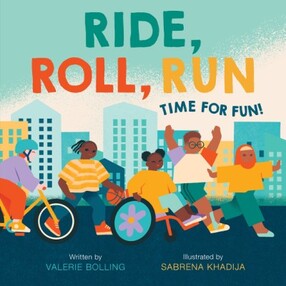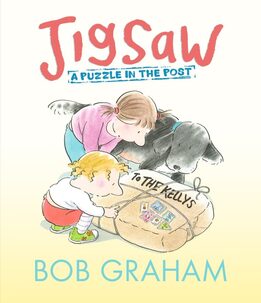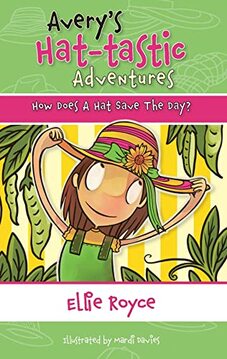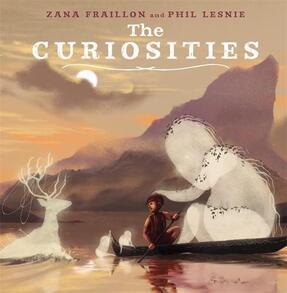 Summer has finally arrived in Hibiscus Gardens, which means it's wedding time! Willa is super excited about her Aunty Jane's upcoming wedding but not so excited about her dress, which she tells her best old-age friend Frank, makes her look like a meringue. Still, it will be loads of fun and her dog, Woof, has the very special job of being the ring bearer. But summer also means bushfire season, and Willa is worried by the smoke rising from the mountains behind the town. Dad tells her not to worry as they head to the beach with her best same-age friend Tae. The wind seems to be changing though, and by the time they are back home, the smoke is bigger and closer. It starts raining - not water - but fire sparks - and they all spring into action packing backpacks, food for Woof and checking to make sure neighbours are safe. Suddenly there's a loud rumbling and raindrops, not fire sparks, fall from the sky. Everyone gathers in the middle of the road clapping and cheering and thankful they are safe. But not everything in the town was saved. Brookside Barn where the wedding was to take place, and where all the wedding dresses were being kept, has burned down, so the wedding is called off. Willa is worried about the koalas near the showground too. With the help of Tae and Frank, Willa hatches a plan to save the koalas, and orchestrate the biggest surprise wedding Hibiscus Gardens has ever seen! Jacqueline Harvey tackles some important concepts for younger readers in this fourth installment of Willa and Woof including bushfires, bullying and wildlife rescue, which she approaches in a way that is meaningful but not confronting. The metaphor of the fire as a dragon is a masterful use of language to impress upon the reader the danger of the bushfire situation. The gravity of rescuing and looking after injured wildlife is portrayed with tension and understanding, with the reader given the opportunity to see the other side of a bully. Seriousness is balanced with humour, and descriptions like 'Ginger Biscuit, the serial killer (cat)', '. . . a giant carrot that looked like it had legs' and 'Her caterpillar eyebrows, Bert and Hilda, . . .' will have readers laughing out loud. Another highly entertaining adventure filled with heart, friendship, compassion and fun, from one of Australia's best known authors. Supporting teaching themes could include bushfires, seasons, friendship, bullies, wildlife rescue, koalas, intergenerational friendships and dogs. Find out more about Jacqueline Harvey Published by Puffin Books an imprint of Penguin Random House Australia Released 4 April, 2023. ISBN: 9781761043345 Highly recommended for ages 6 - 9.
0 Comments
 From the opening lines of ‘School’s done. Ride, roll, run!’ to the final ‘Ride, roll, run. Friends and fun!’, this simple but action-packed rhyming story, takes the reader on a joyful afternoon of possibilities after school has finished for the day. Skateboarding, bike riding, playing basketball and sidewalk games are just a few of the many fun activities these friends get up to. Although not specified in the text, the illustrations highlight the diversity and inclusion of those three words ‘ride, roll, run’ and showcase activities all children love to participate in, no matter their background or ability. Ride Roll Run is Valerie Bolling’s third picture book, written in her distinctive style of sparse, engaging, rhyming text, and readers will connect from the very first page. The playful nature of the story, and clever use of slant rhyme, encourages readers to listen closely, and perhaps even pre-empt the words associated with the actions described in the story. Sabrena Khadija’s bold, uncomplicated and colourful illustrations are the perfect complement to the text. Her use of simple shapes and lines add an exuberant strength to each of the characters, enticing the reader to join in the fun. Ride Roll Run is a celebration of community, friendship and neighbourhoods, and is a wonderful addition to any library collection. Supporting teaching themes could include friendship, community, sports, neighbourhoods, children with disabilities and rhyme. Find out more about Valerie Bolling Find out more about Sabrena Khadija Published by Abrams Books Appleseed Imprint Release date October 4, 2022. ISBN: 9781419756290 (HB) Recommended for ages 3 – 5.  When a parcel arrives at the Kelly house, no-one knows who sent it or where it actually came from. The card attached simply says ‘Good luck to you all.’ Inside the plain brown wrapping they find a jigsaw puzzle of a beautiful African sunrise. The family sets about putting the pieces together. Dad even sets his watch to Late Autumn to allow everyone time to get all the pieces in their right places. As they work their way through the cycle of the seasons and Autumn returns once more, the colourful dawn of the puzzle emerges and the jigsaw is almost complete. But then Dad discovers that – oh no – the piece for the hippo’s swim shorts is missing! They search everywhere, even under their dog Lucy, but it’s nowhere to be found. Then mum realises that it must have accidentally been put out with the rubbish! ‘We’ll find it,’ Dad says, and they drive to the recycling centre where they are presented with an enormous pile of rubbish. They start searching and, although they don’t find the missing puzzle piece, they do find other pieces of people’s lives like letters from faraway places, bus tickets, wedding confetti, photos, old socks and lots of shopping lists. Without realising it Dad has actually trodden on the missing piece and it’s stuck to the bottom of his boot. As he walks through the house it slips off and onto the carpet where Kitty, the youngest Kelly member, finds it. ‘Must have been there the whole time,’ she says. With Autumn nearly over, Kitty places the final piece and her sister straightens it. The jigsaw is finished. With enough stamps to cover its travels, Katie and Kitty post it back to ‘Sumwear’, with their own message attached. From my very first encounter of this brilliant Australian author/illustrator with Greetings From Sandy Beach, through Queenie The Bantam, A Bus Called Heaven, How The Sun Got To Coco’s House and all the others in between, Bob Graham’s latest picture book is yet another superb example of masterful storytelling. With his signature style of softly outlined, colourful illustrations, and underlying themes of family and community, JIGSAW: A PUZZLE IN THE POST is in an uplifting tale of hope, togetherness, and perseverance, and of always being found no matter how lost you think you might be. Supporting teaching themes could include family, recycling, perseverance, community, connections, jigsaws, puzzles, hope, stamps, seasons, waste, letter writing. Find out more about Bob Graham. Published by Walker Books ISBN: 9781529503319 (HB) Highly recommended for ages 3 - 7  Seven year old Avery loves hats. She has forty-nine of them in her room! There is her chef’s hat that helps her make the best cheese toast, her thinking hat that her Dad made that helps her concentrate, her hat with earflaps, her floppy purple hat with corks, and of course, her very special stripey sunshine yellow and bright pink gardening hat, with a green band a big, beautiful sunflower on the brim that helps her grow things. The latter was definitely the hat Avery needed to wear today. She was going to The Patch with her best friend Olivia and Olivia’s dog Gatsby, to help Granny Irene and the other community gardeners pick the vegies for their annual feast. One of Avery’s favourite things in the garden was Sam the Scarecrow, or Sam the un-Scarecrow as they called him. Sam’s face always looked hopeful which is why Avery liked him so much. But today, Mr Laverty was going to take Sam away and make him look scarier. The birds were not frightened of Sam at all and they were eating all the new seeds. Avery pleaded with Mr Laverty not to change him, but her pleas fell on deaf ears. In the middle of their very own sit-down peaceful protest to save Sam, Avery came up with a simple but brilliant idea. A new hat would do the trick! She raced home and brought back all the ones she thought would be suitable but, in the end, decided her own special gardening hat was the obvious choice. But rather than use Avery’s beautiful hat, Mr Laverty remembered he had an old, floppy straw hat they could use instead. It shaded Sam’s face a little so the birds couldn’t see his kind expression. It was perfect! The first in a three-part junior fiction series by author, podcaster and storyteller Ellie Royce, HOW DOES A HAT SAVE THE DAY is a superb addition to the early reader genre. Children who are looking for their first chapter books will easily relate to the characters, friendships and setting of this delightful tale. The sometimes complex ideas of community, inter-generational relationships, multiculturalism and activism have been expertly woven into the story using insightful, unambiguous and engaging language. Mardi Davies’ playful, black and white, cartoon-like illustrations are a wonderful compliment to the writing. Move over Billie B. Brown, here comes Avery and her hats! Supporting teaching themes could include community gardens, community, gardening, inter-generational relationships, friendship, activism and millinery. Find out more about Ellie Royce. Find out more about Mardi Davies Published by We Are All Made of Stories ISBN: 9780646857121 (PB) Highly recommended for ages 5 – 8.  The Curiosities centers around a young boy named Miro, who begins to see the world in a way that is different to others. When the Curiosities first appear they seem to blend in, but gradually they show Miro the 'oddments and snippets', 'wonders and possibles' in the places where no-one else looks. Sometimes the curiosities would show Miro how to tickle songs from the earth, whisper up waves and dance with him deep into the night. The pull of the curiosities gradually became stronger and stronger and soon others in his village begin to notice them too. They became so loud that people began to stare, and no matter what he did, Miro could not tame them. They were almost unbearable, and he felt as though he was vanishing deep inside the earth. Then he heard the whisper of a village elder who helped Miro brush away the darkness of the curiosities. They were still there, but he found the more he connected with people, the easier it was to control them. And he noticed that many others had their own the curiosities too which helped him feel not so alone. There are many who deal with neurodiversities and disabilities, and this book is a wonderful celebration of who we are and how we see ourselves, and encourages us to not to worry too much how others choose to see us. Zana Fraillon is one of my favourite YA authors and she has managed the cross over to picture books flawlessly. Her text is poignant and uplifting, but also challenging, asking us to know ourselves first before we look at how we perceive others. Phil's whimsical and playful images draw us into Miro's world to see what life looks like through his eyes. His clever depictions of the curiosities as recognisable but wisp-like creatures, make us aware but not afraid of them, and inspires us to embrace the curiosities in all of us. Diversity, autism, neurodiversity, acceptance, empathy, perspective, community, culture and mental health are all topics that can be introduced and discussed when using this beautiful and highly recommended book in the classroom. Find out more about Zana Fraillon Find out more about Phil Lesnie Published in 2021 by Hachette Australia ISBN 9780734417848 (HB) Recommended for ages 4 - 8 |
Archives
May 2024
|
|
The Book Tree. © Kerry Gittins 2024. All Rights Reserved. |
Visitors
|
|
|

 RSS Feed
RSS Feed